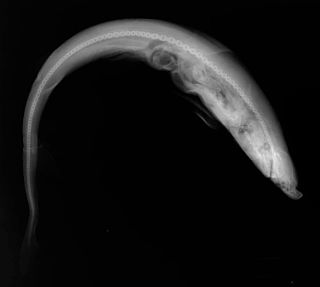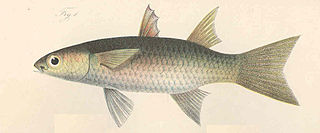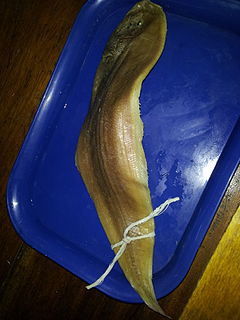
"Sardine" and "pilchard" are common names used to refer to various small, oily fish in the herring family Clupeidae. The term "sardine" was first used in English during the early 15th century and may come from the Mediterranean island of Sardinia, around which sardines were once abundant.

Phoenix canariensis is a species of flowering plant in the palm family Arecaceae, native to the Canary Islands. It is a relative of Phoenix dactylifera, the true date palm. It is the natural symbol of the Canary Islands, together with the canary Serinus canaria. Mature P. canariensis are often used in ornamental landscaping and are collected and transplanted to their new planting location. A Canary Island Date Palm with 10 m (30 ft) of trunk is approximately 60 years of age.

The Canary Islands chiffchaff is a species of leaf warbler endemic to the Canary Islands, Spain. Sometimes the English name is spelled Canary Island chiffchaff.

The Atlantic weasel shark is a weasel shark of the family Hemigaleidae, found in the Eastern Atlantic Ocean. Also known as the little tiger shark, it is the only species of the genus Paragaleus to have been recorded off the western coast of Africa. It is one of four species of small sharks within the carcharhinoid genus Paragaleus, including Paragaleus leucolomatus, Paragaleus tengi, and Paragaleus randalli. It also one of eight species within the weasel shark family, Hemigaleidae. It is currently considered by the International Union for Conservation of Nature and Natural Resources Red List of Threatened Species (IUCN) as data deficient due to lack of availability of specific information on catches and population trends of the species.

The Canarian shrew is a species of mammal in the family Soricidae. It is endemic to the Canary Islands, specifically the eastern islands of Lanzarote, Fuerteventura, Lobos, and Mount Clara. It used to be found on Graciosa, Canary Islands and Alegranza. Its natural habitat is subtropical or tropical dry shrubland. It is threatened by habitat loss.

Arbutus canariensis, known in Spanish as madroño canario, is a species of shrub or tree in the heath family. It is endemic to the Canary Islands of Spain, specifically Tenerife, La Gomera, Gran Canaria, El Hierro, and La Palma. It is threatened by habitat loss.

Euphorbia canariensis, commonly known as the Canary Island spurge, Hercules club or in Spanish cardón, is a succulent member of the genus Euphorbia and family Euphorbiaceae endemic to the Canary Islands. It is the plant symbol of the island of Gran Canaria.

Cynoglossus is a genus of fish in the family Cynoglossidae. Most species are indigenous to the Indo-Pacific region, but there are also a few in warmer parts of the East Atlantic. They are commonly found in shallow waters on a muddy or sandy bottom, including estuaries and a few species are restricted to fresh water. One species Cynoglossus sinusarabici has invaded the Mediterranean Sea through the Suez Canal from the Red Sea, a process known as Lessepsian or Erythrean migration.
Cynoglossus browni, commonly known as the Nigerian tonguesole is a species of tonguefish. It is commonly found in Eastern Atlantic Ocean off the coast of west Africa, from Senegal to Angola. It is found on soft substrates such as mud or sand between depths of 15m and 40 m. Its main food is small benthic invertebrates.
Cynoglossus cadenati, commonly known as the Ghanaian tonguesole is a species of tonguefish. It is commonly found in the eastern Atlantic Ocean off the coast of west Africa from Mauritania to Angola, including the Cape Verde Islands. It is found on sand and mud bottoms of coastal waters.

Cynoglossus feldmanni, commonly known as the River tonguesole is a species of tonguefish. It is commonly found in Thailand, Laos, Borneo, Sumatra and Cambodia. It occurs in rivers in freshwater well above the tidal zone where it lives on the bottom feeding on benthic invertebrates.

Sardinella maderensis is a species of small ray-finned fish in the genus Sardinella which is found in the Eastern Atlantic and Southeastern Mediterranean. it is a silvery fish similar to the round sardinella, but can be distinguished from that species by having gray caudal fins with black tips. It feeds on phytoplankton and fish larvae and is a pelagic, oceanodromous species that forms schools in coastal waters, often mixed with S. aurita. The International Union for Conservation of Nature has rated this fish's conservation status as "vulnerable".
Halosaurus johnsonianus, also called the Sahara halosaur, is a deep-sea fish in the family Halosauridae. It is found in the eastern Atlantic Ocean from southern Spain and Portugal to Mauritania, including the Azores and Canary Islands. It is a benthopelagic species living on the continental slope in depths from 800 to 2,200 m. It grows to 50 cm (20 in) total length.
Vanstraelenia chirophthalma, the African solenette, is a species of sole native to the Atlantic coast of Africa where it is found from Guinea-Bissau south to Angola. Occurring at depths of from 8 to 100 metres, this species is of importance to local commercial fisheries. This species grows to a length of 28 centimetres (11 in) TL. This species is the only known member of its genus.

Umbrina canariensis, the Canary drum is a warm water, marine fish of the family Sciaenidae which is found in the western Mediterranean, eastern Atlantic Ocean and western Indian Ocean. Other English vernacular names are tesselfish, baardman, checker drum, common baardman, tasselfish and bellman.

Tamarix canariensis is a species of flowering plant in the family Tamaricaceae. It is a shrub or small tree up to 4 m tall. It was previously said to be native to parts of Macaronesia, northern Africa and south-western Europe, but is now considered only to be found in the Canary Islands, the African and European species being Tamarix gallica. It was first described by Carl Ludwig Willdenow in 1816.
Merluccius polli, the Benguela hake, is a species of fish from the family Merlucciidae, the true hakes. It is found in the tropical waters of the eastern Atlantic Ocean off the west coast of Africa.
The sicklefin mullet is a species of ray-finned fish, a grey mullet from the family Mugilidae which is found in the eastern Atlantic Ocean of the coasts of western Africa. It is the only species in the monospecific genus Neochelon.

The largescaled mullet is a species of ray-finned fish from the family Mugilidae. It is found in the eastern Atlantic from Mauritania to the Gulf of Guinea. It is the only species in the monospecific genus Parachelon.

















